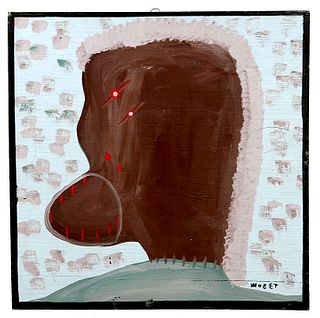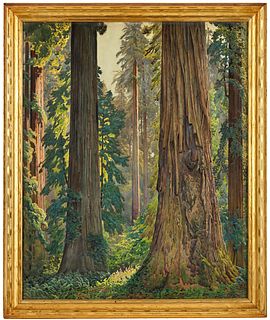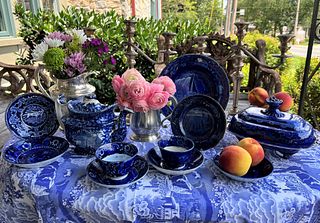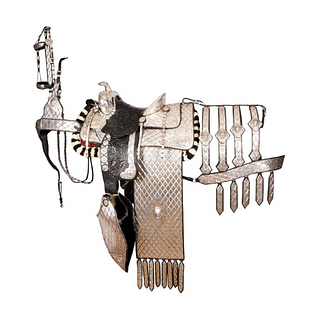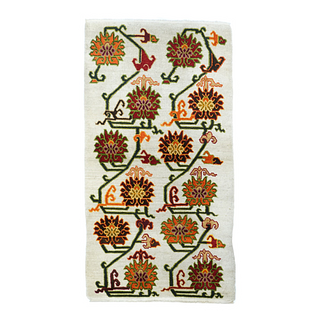Condition, Condition, Condition
What to Look for When Bidding on Fine Art at Auction
Buying paintings and works on paper at auction can be an exhilarating experience, but it can also be nerve-wracking, as many factors influence the decision as to whether to pursue a particular lot. One key aspect buyers should keep in mind is the condition of any piece they plan to bid on, as works at auction are sold “as-is.” A certain amount of wear-and-tear is to be expected for artwork with any age, but being aware of either past restoration or restoration that needs to be done can influence the decision on whether or not to bid.
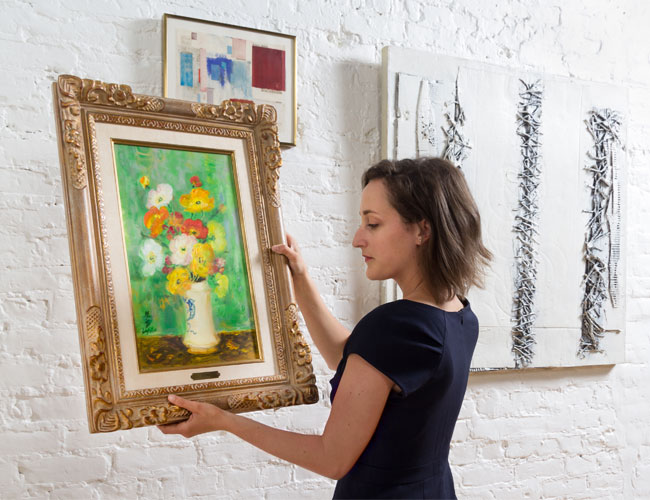
To better understand a work’s condition, it is preferable for a potential buyer or someone they trust to view it in person. Auction house specialists are always happy to show interested clients any lots that might catch their eye. When inspecting a painting, basic issues to look for include tears, holes, paint loss, and whether or not a painting has been lined or placed on new stretchers. Always make sure to look at the front and reverse of an artwork. Another concern is inpainting, a method used by conservators to replace paint loss or hide craquelure. Inpainting can be seen under UV, and a dark closet and blacklight should be provided if asked for. Things to look out for with works on paper include tears, creases, foxing, and toning, as well as how the piece is mounted to its support.
Of course, with the growth of online auctions in the digital age, seeing a work in person is not always possible. Many auction houses provide condition reports for individual lots on their websites, and all will email them upon request if not published online. Condition reports include the full cataloging for an artwork, and describe the type and location of any damage or unusual characteristics. In addition to the report, photos of the artwork’s front, reverse, and signature are usually provided, as well as a photo of the work in its frame. Detailed shots of any significant condition issues, such as tears or paint loss, should also be included. If it is a work on paper, expect to see images of the piece out of its frame and mounting. A bidder should never be embarrassed to ask for any additional photos they might like to see. At the end of this article can be found a list of the more common terms used in condition reports, along with their definitions.
If no damage is present, a lot will be listed as: “Appears in basic good condition; Under UV, no evidence of restoration or retouch.” This is the best-case scenario, as it means the artwork needs no restoration and can be hung as soon it arrives in the lucky winner’s home. Of course, if a painting or work on paper requires restoration or has been previously conserved, this should not be a deterrent from bidding. Collectors should pursue pieces they are passionate about, whether or not they need a bit of care, but it wise to do so with an informed opinion and open eyes.
Common condition terms used by auction houses:
Accretion: A surface deposit of foreign material such as dried liquid residue, foodstuff, or fly specks.
Bloom: Occurs when moisture penetrates a varnished surface, causing cloudy areas to appear.
Canvas Relined: When the original canvas of a painting has been damaged or weakened, the piece is removed from its stretchers, backed in linen or canvas, and placed on its original stretchers or on new ones.
Canvas Re-stretched: When the original canvas of a painting has been tightened on its original stretchers, or taken off of its original stretchers and placed on new ones.
Craquelure: A network of fine cracks on a paintings surface.
Creases: Occur when a material has been folded or bent, creating a line or ridge on the surface without breaking or tearing.
Fading / Bleaching: Loss of brightness and/or brilliance of color.
Foxing: Reddish-brown mold spots that appear on paper and textiles.
Inpainting: Application of paint used to replace paint loss or disguise craquelure. Inpainting can usually be revealed through the use of a UV light.
Lifting: A form of deterioration in which pieces of paint or paint and ground are partially detached and elevated above the paint surface.
Mat Burn: Discoloration of work on paper where an acidic mat material contacts it.
Overpainting: Paint retouch of a damaged area on an item that extends beyond the confines of a loss into undamaged areas.
Paint Loss: The absence of paint in areas where it was previously located.
Remains of Hinges: Works on paper, prints, and photographs are often attached to a mat with paper hinges, and remnants of these hinges can sometimes remain if the piece is removed from the original mounting.
Rippled Paper: When environmental influences cause disruptions, ridges, or buckling of paper.
Skinning: Excessive cleaning that removes a portion of the original media.
Staining: Occurs when foreign materials react with the surface of an item and create discoloration or spotting.
Surface Soiling: Accumulation of dirt, or other materials, upon the face of an item, including fingerprints.
Tears / Holes: Openings in a surface caused by forcibly pulling the piece apart.
Toning: Toning is the darkening or aging of paper over time.
Trimmed Margins: When the margins of a two dimensional work of art have been reduced.
Water Damage / Warping: Includes any type of damage caused by contact with water or humidity such as staining, warping or loosening of material.
- Quilts as a 2025 Design Trend: A Celebration of American Heritage and Craftsmanship
- A Celebration of Sports History and Collectibles
- The Thrill of Sports Memorabilia Auctions: A Collector’s Paradise
- Demystifying Coin Condition: A Guide to the Sheldon Grading Scale
- Snoopy & Friends: A “Peanuts” Auction at Revere
- Colorful Chinese Monochromes at Millea Bros
- 12 Holiday Gifts for the “Impossible to Buy For” on Bidsquare
- Alluring Art Objects and Accessories from the Estate of Chara Schreyer
- Kimball Sterling's One-Owner Outsider and Folk Art Collection Showcases Masters of the Unconventional
- The Moke Mokotoff Collection of Asian Art at Stair



 EUR
EUR CAD
CAD AUD
AUD GBP
GBP MXN
MXN HKD
HKD CNY
CNY MYR
MYR SEK
SEK SGD
SGD CHF
CHF THB
THB

